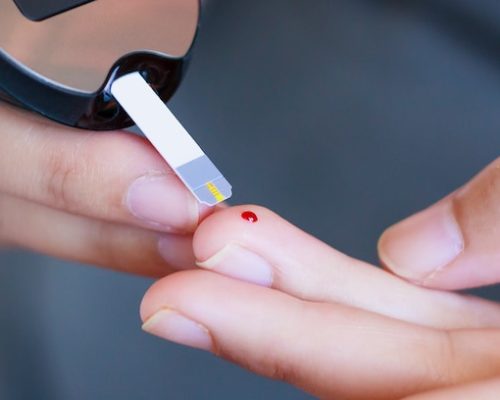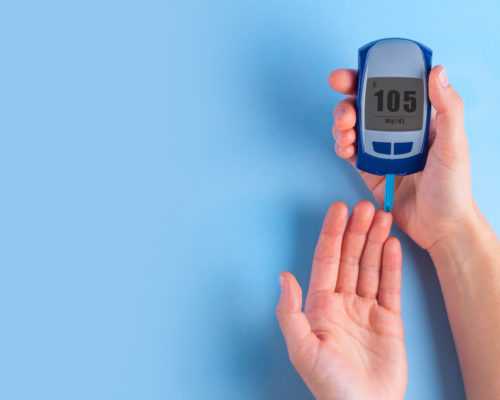People with diabetes know very well that monitoring their blood glucose levels is vital to managing their diabetes and preventing the effects of chronically high blood sugar.
The two main methods of measuring blood glucose levels are:
- CGM (continuous glucose monitoring)
- BGM (blood glucose monitoring)
Each method works differently and can even give a slightly different result, but both effectively monitor levels and ensure diabetes is managed appropriately.
Table of Contents
The Benefits of Consistent Glucose Monitoring
Having a reliable system to measure glucose levels is vital for those with diabetes, as the effects of high and low blood sugar can be very dangerous.
Typically, these fluctuations in blood glucose levels happen during the night while asleep. Depending on how high or low they are, someone can quickly become unwell if not monitored and treated accordingly.
Your blood glucose levels can trigger whether you need to take a dose of insulin or eat something to curb your blood glucose. Inconsistent monitoring of blood sugar can lead to:
- Feeling ill
- Damaged blood vessels
- High blood pressure
- Heart disease
- Heart attack
- Kidney disease
- Kidney failure
- Eye problems like retinopathy, cataracts, glaucoma
- Nerve damage
- Swollen limbs
The list could go on, and if you have diabetes you’re aware of the risks of not managing it properly. And a simple solution is using CGM or BGM, but ideally, both, to measure your blood glucose accurately and consistently.
The Differences Between CGM and BGM
Continuous Glucose Monitors (CGMs) are a wonderful technology that allows people with diabetes to see an ongoing set of glucose results as a trend line. Meanwhile, Blood Glucose Monitors (BGMs) are individual glucose results from lancing a finger and measuring the glucose in that blood sample.
Continuous Glucose Monitoring
CGM works by sending a signal from the sensor (attached to the body) to a transmitter, which sends the data to a receiver or mobile device. This allows for around-the-clock monitoring of glucose levels and trends.
This is beneficial because it can kick out a lot of data that can show levels of glucose over time and how it raises or lowers throughout the day. It’s also very hands-off which can be helpful for people with busy lives who don’t want to, or can’t, stop to get a blood glucose reading consistently. It also can mean fewer finger pricks as long as the sensor is doing its job.
Blood Glucose Monitoring
BGM is a method of glucose monitoring people are most often familiar with. It requires a finger prick and uses a drop of blood to measure glucose levels in that spot. It’s quick and painless, but the main drawback is it only gives you one reading versus the entire data set CGM provides.
Comparing CGM and BGM
People will naturally try to compare these two results as both are indicators of glucose levels. But when a comparison is made, it is vital to understand the differences between CGM and BGM.
The primary difference is BGM measures glucose in the actual blood while CGM measures glucose in the interstitial fluid.
Interstitial fluid is found in spaces around the body’s cells. It comes from substances that diffuse out of blood capillaries. One of the substances that comes out of the capillaries is glucose.
Because a sensor can survive longer in the interstitial fluid versus blood, CGM sensors only penetrate under skin far enough to be in the area of interstitial fluid.
The glucose in the bloodstream initiates from the digestion of what a person eats. The blood in the capillaries carries the glucose to all parts of the body for nutrition.
Therefore, the truest number of glucose levels is in the blood. So a BGM reading from a blood sample gives the most accurate glucose reading. However, glucose does, over time, diffuse out of the capillaries into the interstitial fluid, where a CGM sensor can read it.
What if Your CGM and BGM Readings Are Different?
Because of moving from the bloodstream to the interstitial fluid, the interstitial glucose level (CGM) is delayed, and may not reach the same peak as the blood glucose level (BGM). This can give you two different readings.
As an example of this difference, consider the graph below that shows the relation of one study to compare BGM and CGM.
At 180 minutes after ingesting carbohydrates, the BGM measurement of glucose in the blood peaks at 280 mg/dl, but the CGM result of glucose in the interstitial fluid only shows 220 mg/dl at the same time. And the interstitial glucose never reaches the same peak of the glucose in the blood.
This delay between BGM and CGM will most often show up when glucose is changing, which is likely:
- After eating
- After exercise
- After taking medications
The Pops Rebel meter was used while wearing an Abbott FreeStyle Libre to compare results. Accuracy was overall good with two key findings:
During the 1-2 hours after eating, the Pops Rebel picked up the glucose rise more quickly than the CGM, so Pops was as much as 20% higher in results than the CGM.
During times of rest and no eating where the CGM trend line was flat, indicating glucose was stable, the difference between the Pops Rebel and CGM was less than 4%.
Other factors also affect CGM accuracy and should be considered to compare it to a BGM. Two key factors:
- The beginning and end of life of a sensor can result in different accuracies
- Applying pressure to the area of the body where the CGM sensor is worn can affect the accuracy.
A good rule of thumb might be that if your CGM shows a high reading, it could be a good idea to double up and get a blood glucose reading to get a more accurate measurement. Then, you can act appropriately and also see just how different the two readings might be.
Tips for Getting the Best, Most Accurate Blood Glucose Readings
Utilizing your CGM or BGM to the fullest is the best way to manage your blood glucose levels and diabetes. On top of that, to get accurate readings, you should:
- Learn how to interpret and understand your readings.
- Always wear a CGM or BGM sensor with its accompanying pump, even when taking insulin as your doctor directs.
- Keep your glucose meter in the same place at all times for optimal accuracy. Accuracy can be affected by changes in calibration from different temperatures and environments.
- Be sure your insulin pump is calibrated, in working order, and has enough battery.
- Be aware of where the sensor site is on your body. Work with your doctor to figure out the optimal placement for your sensor, and change it during the appropriate timeline.
- If you are unsure of your blood glucose results, test again with a different device or in another way to confirm your findings.
Comparisons of two different methods of checking glucose can be difficult, and it is necessary to understand these differences before relying on one or the other.
Tools for Getting the Most Accurate Readings
To ensure the most accurate readings, you can use the best, most accurate devices. The Pops Rebel Blood Glucose Monitoring System is the simplest way to measure your glucose throughout the day. It can send information directly to your providers so you can get in-time results and feedback to stay on top of your diabetes treatment.
For the best results yet, contact Pops Diabetes Care, or purchase your own Rebel Blood Glucose Monitoring System to get started!










